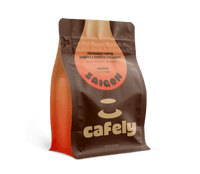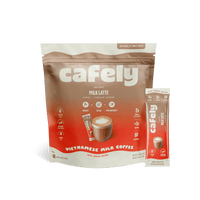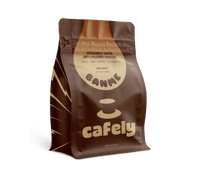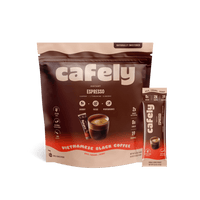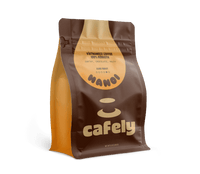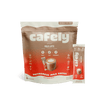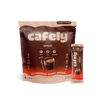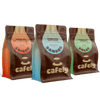Decaffeination involves removing as much caffeine from coffee beans as possible, but how exactly do they remove caffeine from coffee?
The process of removing caffeine from coffee was invented in the early 1900s and initially made use of a potentially toxic chemical. As research and technology progressed, we’ve streamlined the decaffeination process, improving its efficiency and safety.
In this article, we’ll be looking at each decaffeination method so you can learn more about the art of decaf coffee creation.
What are the 4 Common Methods of Decaffeinating Coffee?

Decaf coffee can be made in numerous ways such as the direct or indirect solvent process, the Swiss Water method, or using carbon dioxide. Each decaffeination process, roast, and coffee bean used can result in various flavor profiles in the final product.
Decaf coffee only contains a minimal amount of caffeine, potentially curbing some negative side effects associated with caffeine such as restlessness, nervousness, palpitations, and insomnia [1].
Related: How To Stop Heart Palpitations From Caffeine?
Direct Solvent Process
Often referred to as the ‘traditional’ method for decaffeinating coffee beans, the direct solvent process was first introduced in the early 20th century [2]. This process initially involves steaming the coffee beans before soaking them in a solvent (usually methylene chloride or ethyl acetate) for around 10 hours. This process works to rid the beans of caffeine. The beans are then rinsed, flushed, or steamed to remove any residue of the solvents, before being dried and roasted.
In the past, trichloroethylene was used as a solvent when making decaf coffee. However, links have been made between trichloroethylene and cancers in humans [3]. Today, methylene chloride and ethyl acetate are favored for the direct solvent decaffeination process.
Indirect Solvent Process
As hinted in its name, the indirect solvent process for decaffeination doesn’t involve soaking the beans directly into any solvents or chemicals. Instead, the green coffee beans are soaked in hot water for several hours. This removes the caffeine from the beans and infuses it into the water. The liquid solution is then paired with a solvent and filtered to remove the caffeine before being reintroduced to coffee beans.
The solvent most commonly used for the indirect solvent process is ethyl acetate. It is naturally occurring, and caffeine molecules successfully bond with it when making decaf tea and coffee.
The infused water may still contain minimal caffeine. However, the important oils and flavors of the coffee beans remain which can be absorbed when the beans are reintroduced. Since only the caffeine is removed, the beans remain flavorful and rich.
Swiss Water Method
Branded a “fully natural” decaffeination process, the Swiss Water method removes caffeine from coffee beans using minimal additions [4]. Green coffee beans are soaked in a water solution for approximately 10 hours. This allows them to reach their optimal moisture level to remove the caffeine, along with any dirt, dust, or debris.
The green beans are then soaked in green coffee extract (GCE) for up to 10 hours. The GCE is a proprietary caffeine-free water or extract infused with flavorful coffee molecules or compounds. While soaking, the caffeine “leaks out” of the green beans and moves to the GCE through a process called osmosis. However, the flavorful compounds that give coffee its distinctive aroma and flavor profiles remain in the green beans. This process is repeated until the green beans are 99.9% caffeine-less. The coffee beans can then be dried and roasted with the natural flavors and aromas of the beans remaining.
The GCE, now saturated with caffeine, goes through a carbon-filter process to remove most of the caffeine. When it’s completely caffeine-free again, it can be reused for the next batch.
The Swiss Water method is a patented method of decaffeinating coffee. It remains a chemical-free, natural option, involving no chemical additives.
Carbon Dioxide Method
Carbon dioxide can also be used to remove caffeine from coffee beans, with the process starting with soaking green coffee beans in water. Once soaked, the beans are moved to a pressure chamber where liquid carbon dioxide (CO2) is introduced. The carbon dioxide acts as a solvent, extracting and dissolving caffeine from the coffee beans.
The caffeine-infused CO2 is then moved to a low-pressure absorption chamber where it transitions back into a gas state. The process leaves behind decaffeinated coffee beans, which can then be dried, roasted, and used to make countless cups of decaf coffee.
What are the Pros and Cons of Decaf vs Regular Coffee

Coffee is the perfect beverage when you need a pick-me-up or a delicious accompaniment to a tasty snack. But can you enjoy the same when you drink decaf?
Let’s go over a few pros and cons of decaf coffee and see how it compares with regular coffee.
Less Caffeine
Decaf coffee has an obvious difference from regular coffee. The reduced caffeine content in decaf coffee means less caffeine side effects like jitters or caffeine crashes.
If you find you’re experiencing some of the negative effects of caffeine, introducing decaf coffee into your routine could be worth it.
If decaf is not your thing but you want something with lower caffeine content, then you should try Cafely’s 100% arabica coffee, Da Lat. You could also try arabica/robusta blends like Da Nang or our bestseller Sai Gon OG. Arabica beans have lower caffeine content than robusta.
Same Health Effects
Decaf coffee contains a fraction of caffeine compared to regular coffee, but this doesn’t necessarily make it healthier. Caffeinated and decaffeinated beverages have the same health benefits, so drinking decaf may not wipe out the advantages found in regular coffee.
The decaffeination process may have removed the majority of caffeine, but the other beneficial compounds still remain in the coffee. These beneficial compounds can have positive effects on Type 2 diabetes risk, some neurogenerative diseases, and cognitive decline [5]. For individuals managing hypertension, opting for the best decaf coffee for high blood pressure can be a smart way to enjoy coffee's benefits without the risks of too much caffeine.
Due to decaf’s reduced caffeine content though, you may also experience fewer symptoms associated with high caffeine consumption. This can benefit you, health-wise, if you’re negatively affected by caffeine. You can also check out Cafely's arabica beans if you want something with a small punch.
Related: Is Vietnamese Coffee Healthy? (Benefits Explained)
Weaker Taste
Many coffee consumers drink coffee not only to benefit from the caffeine buzz but to enjoy the bold taste as well. However, the decaffeination process may not only remove caffeine but also strip away some of its flavorful compounds, resulting in weaker flavored coffee which may not suit everyone’s taste buds. This especially happens when coffee beans of poor quality are used.
It’s worth investing in high-quality decaf coffee to achieve an experience as close to regular coffee as possible.
Fewer Options
When searching for decaf coffee options, you may find your choices are somewhat limited, especially when looking in-store. If you struggle to find a decaf blend to fall in love with, search online at specialty coffee stores where you will have more choices of flavor combinations and varieties.
FAQs
Got more questions? Here are some commonly asked questions about decaf coffee.
1. When was decaffeinated coffee invented?
Decaf coffee was invented by Ludwig Roselius in the early 1900s in Germany, before being introduced to the rest of Europe. Roselius discovered that caffeine was water soluble, leading him to create ways of minimizing caffeine in coffee beans — a process that offered deeper insight into how coffee is really made, especially at the chemical level.
2. Is decaf coffee completely free of caffeine?
Contrary to popular belief, decaf coffee isn’t entirely free of caffeine. It contains a substantially lower amount than regular coffee, but a minute amount of caffeine remains, even after decaffeination.
3. How much caffeine is in decaf coffee?
Decaffeination is successful in removing a minimum of 97% of the caffeine content from coffee beans. A standard cup of regular coffee contains around 95 mg of caffeine which is far higher than a cup of decaf which only contains 2 mg of caffeine [6].
If you’re drinking Vietnamese coffee, know that it contains higher caffeine levels. Vietnamese coffee makes use of robusta beans, a type of coffee bean that contains more caffeine than arabica. Cafely's premium robusta products are great examples of the ones best used for Vietnamese coffee.
Related: What Makes Vietnamese Coffee So Strong?
4. Is coffee decaffeination process safe?
The coffee decaffeination process is safe and actively works to reduce caffeine from coffee beans effectively. The methods involving chemicals are also deemed safe, as the solvents leave a negligible trace on the final coffee beans.
5. Does decaffeinated coffee taste different?
Caffeine doesn’t carry much of a taste other than being bitter, but the decaffeination process and roasting of the beans can deliver a taste different from regular coffee. If produced on a mass scale and using poor-quality beans, decaf coffee can have a distinct burnt, bitter flavor.
When processed in smaller batches, using quality beans and a reliable decaffeination method, decaf coffee can be just as delicious and robust as regular coffee. But you can always try Cafely's flavored coffee if you want something for a change.
References:
- Rodak, K., Kokot, I., & Kratz, E. M. (2021). Caffeine as a Factor Influencing the Functioning of the Human Body – Friend or Foe? Nutrients, 13(9).
- Myhrvold, N. (2022). decaffeination. Encyclopedia Britannica.
- Chiu, W. A., Jinot, J., Scott, C. S., Makris, S. L., Cooper, G. S., Dzubow, R. C., Bale, A. S., Evans, M. V., Guyton, K. Z., Keshava, N., Lipscomb, J. C., Stanley Barone, J., Fox, J. F., Gwinn, M. R., Schaum, J., & Caldwell, J. C. (2013). Human Health Effects of Trichloroethylene: Key Findings and Scientific Issues. Environmental Health Perspectives, 121(3), 303-311.
- Eve M Glazier, MD, Elizabeth Ko, MD, Health benefits of coffee remain in decaf version. UCLA Health.
- National Coffee Association of U.S.A. Inc. Get the facts about decaffeinated coffee.
